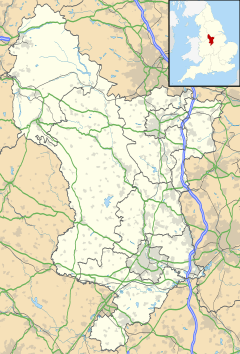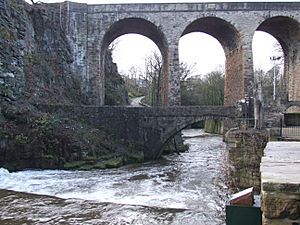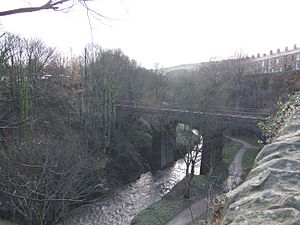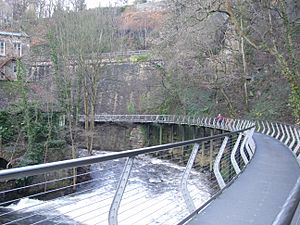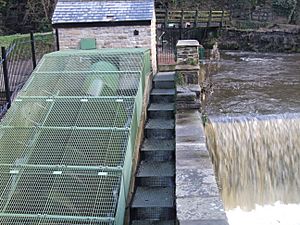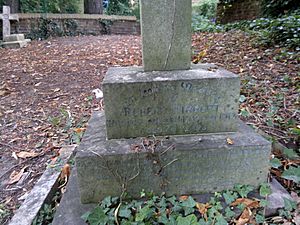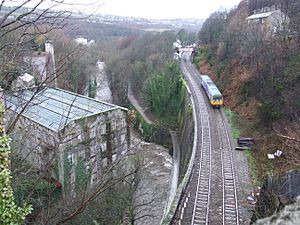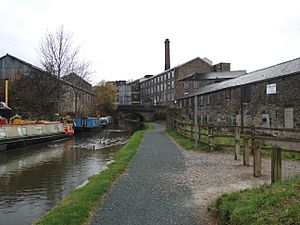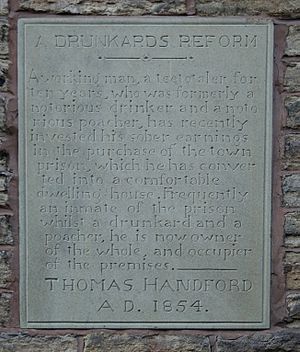New Mills facts for kids
Quick facts for kids New Mills |
|
|---|---|
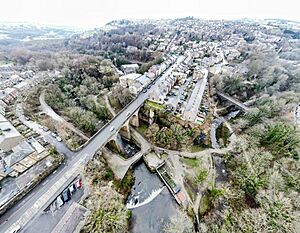 Two rivers, two railways, a canal, and various roads all converge to form a town on differing levels. Hills rising out to the nearby Peak District surround the central viaducts and bridges. |
|
| Population | 12,291 (2011) |
| OS grid reference | SJ995855 |
| Civil parish |
|
| District |
|
| Shire county | |
| Region | |
| Country | England |
| Sovereign state | United Kingdom |
| Post town | HIGH PEAK |
| Postcode district | SK22 |
| Dialling code | 01663 |
| Police | Derbyshire |
| Fire | Derbyshire |
| Ambulance | East Midlands |
| EU Parliament | East Midlands |
| UK Parliament |
|
| Website | New Mills Town Council |
New Mills is a town in Derbyshire, England. It's about 8 miles south-east of Stockport and 13 miles from Manchester. The town is where two rivers, the River Goyt and Sett, meet. It's also very close to the border with Cheshire.
New Mills is known for its deep gorge called the Torrs, which is about 70 feet deep. This town is on the edge of the beautiful Peak District National Park. Around 12,000 people live in New Mills. The area also includes smaller villages and hamlets like Whitle, Thornsett, Hague Bar, Rowarth, Brookbottom, Gowhole and Birch Vale.
Long ago, New Mills was famous for coal mining. Later, it became a big center for making cotton, bleaching fabrics, and printing patterns on cloth. The town was well-connected by the Peak Forest Canal, three railway lines, and the A6 road. Today, a sweet company called Swizzels Matlow uses some of the old mill buildings. New Mills also has a strong history with the Methodist religion. The town is twinned with Alsfeld, a town in Germany. There's even a road named Alsfeld Way in New Mills!
Contents
- Exploring New Mills' Past: A Brief History
- New Mills' Location and Landscape
- New Mills' Economy: From Mills to Sweets
- Famous Spots: Landmarks of New Mills
- Places of Worship: Religious Sites
- Getting Around: Transport in New Mills
- Fun and Events: Culture and Community
- Local News and Media
- Learning in New Mills: Education
- Protecting History: Conservation Area
- Sports and Fun: Leisure Activities
- Famous Faces: Notable Residents
- See also
Exploring New Mills' Past: A Brief History
New Mills is located in an area once known as Bowden Middlecale. The name "New Mills" came from a corn-mill built in 1391 near the River Sett. Over time, houses grew up around this mill, and the name stuck.
Coal mining was the first big industry here, with many small mines. The area was perfect for cotton spinning because of its climate, good stone for building, and fast-flowing rivers. From 1788, cotton mills and print-works were built in the Torrs Gorge. People even built homes on the sides of the gorge, sometimes one on top of another, each with its own street entrance!
By 1810, New Mills had nine cotton mills, three weaving mills, and at least three printworks.
How New Mills Grew: Mills and Canals

More mills were built in Newtown, a nearby hamlet, when the Peak Forest Canal opened. These new mills and houses eventually became part of New Mills. The soft, iron-free water was great for bleaching and printing fabrics. As steam power and canals grew, larger mills became more successful, and the smaller ones struggled. By 1846, many of New Mills' cotton mills had stopped spinning. Some mills changed to other types of work, while larger ones focused on finishing fabrics. Torr Vale Mill, for example, started making towels in 1836.
A special way of printing patterns on cloth using engraved rollers was invented in New Mills in 1821.
Bridges and Railways: Connecting the Town
The deep Torrs gorge made travel difficult. People had to go down 70 feet to cross the River Goyt and then climb back up. The first bridge was Queens Bridge. The Union Road bridge was built in 1884, connecting the two parts of the town.
The first railway station in New Mills opened in 1855 at Newtown. Later, two large viaducts (bridges for trains) were built across the River Goyt. One led to New Mills Central (opened 1864), and another for a faster line through the Disley Tunnel (opened 1904).
Cotton continued to be made at Torr Vale Mill for over 200 years, until 2000.
Floods: Nature's Power
New Mills has experienced powerful floods. In June 1872, a big storm caused the River Goyt to rise very high. Some mills were damaged, and buildings were washed away, but luckily, only two cows were lost.
A more serious flood happened in June 1930. Heavy rain caused the River Sett to rise quickly, by up to 20 feet! Many homes were flooded and destroyed. Roads were washed away, and buildings collapsed.
You can see a model of the town from 1884 at the New Mills Heritage and Information Centre.
New Mills' Location and Landscape
New Mills is about 182 miles north-west of London. It's next to Disley in Cheshire and Marple in Greater Manchester. The town is on the edge of the Peak District, but only the eastern part of the area is inside the National Park.
The town includes smaller areas like Thornsett, Hague Bar, Rowarth, Brookbottom, Gowhole, and most of Birch Vale. Different parts of the town have local names, like Eaves Knoll, High Lee, Hidebank, Low Leighton, and Torr Top.
The lowest part of the town is about 120 meters (394 feet) above sea level. However, the valley sides rise to 370 meters (1,214 feet) near Rowarth. The rivers, including the Sett and Goyt, flow through the town. The Goyt valley is home to two railway lines, the Peak Forest Canal, and the A6 road, which all pass through New Mills.
The rocks under New Mills are very old, from the Carboniferous period. Coal has been mined in over 30 places here. The deep Torrs Gorge was carved out by the Rivers Goyt and Sett.
 |
Marple | Mellor, Rowarth, Glossop | Birch Vale, Little Hayfield |  |
| High Lane, Disley | Hayfield, Kinder Scout | |||
| Lyme Park | Furness Vale, Whaley Bridge | Chinley, Chapel-en-le-Frith |
New Mills' Economy: From Mills to Sweets
New Mills' economy started with farming, then coal mining, and later cotton making and bleaching. While the mills have now closed, Swizzels Matlow, a company that makes children's sweets, is a major employer today. The company moved to New Mills during World War II and has been there ever since.
There was also a history of working with iron in New Mills. Today, tourism is important, especially since the Torrs was opened as a riverside park in 1984. The Millennium Walkway, opened in 1999, also helps attract visitors.
The Plain English Campaign, an organization that promotes clear language, has its main office in New Mills. Since 2015, New Mills has also had a small brewery called Torrside Brewing.
Famous Spots: Landmarks of New Mills
New Mills is famous for The Torrs, a dramatic gorge where the Rivers Goyt and Sett flow. Inside a bend of the Goyt is Torr Vale Mill, a very old and important building.
The Torrs Millennium Walkway is a special path built over the gorge. It cost a lot of money (over £500,000!) and was opened in April 2000. Part of the walkway stands on stilts in the river, and another part hangs off the railway wall. It completes a long walking path called the Midshires Way.
Torrs Hydro is a unique project at the Torr Weir on the River Goyt. It uses a giant screw, like a reverse Archimedes' screw, to generate electricity from the river's flow. This "Archie" turbine makes 50 kilowatts of electricity. It's owned by the community! The electricity powers the local Co-operative supermarket, and any extra goes back into the main power grid.
Places of Worship: Religious Sites
The New Mills area has a strong Methodist history. John Wesley, the founder of Methodism, preached here many times starting in 1740. The first Methodist chapel in town was built in 1766. Many mill owners were Methodists and supported the church.
The Friends Meeting House in Low Leighton dates back to 1717. The Congregational church, "Providence," was built in 1823.
The Church of England church of St George's was built in 1829–30. Another Anglican church, St James the Less, built in 1880, is now an arts center.
The Roman Catholic church, the Church of the Annunciation, was built in 1846 and has a tall spire.
Getting Around: Transport in New Mills
Train Travel
New Mills has two train stations: New Mills Central and New Mills Newtown. New Mills Central is on the north side of the River Goyt, and New Mills Newtown is on the south side. A faster train line between Manchester and Sheffield also passes through the town, but it doesn't stop at these stations.
Until 1970, a short train line went from New Mills Central to Hayfield. This old route is now the Sett Valley Trail, a path for walking and cycling.
Bus Services
Several bus services run through New Mills. High Peak buses connect the town to places like Macclesfield, Hayfield, Glossop, and Buxton. Stagecoach Manchester also runs a service from Stockport to Hayfield. Another High Peak bus service connects Newtown to Manchester Airport via Stockport.
Roads
The A6 road passes through Newtown, heading north towards Stockport and Manchester, and south towards Chapel-en-le-Frith and Buxton. The A6015 road connects New Mills to the A6 and to Hayfield. The B6101 road links the town to nearby Marple.
Canal Boats
The Peak Forest Canal opened in 1796. It goes through Newtown, where there's a marina called New Mills Marina. The canal heads north towards Disley and Marple, and south towards Whaley Bridge.
Fun and Events: Culture and Community
New Mills Town Council puts on a free bonfire and fireworks display in High Lea Park every November. It's a very popular event, attracting thousands of people! New Mills also hosts the One World Festival each year in High Lea Park.
The biggest event in town is the New Mills Festival. It takes place over two weeks in September. There are talks, walks, concerts, exhibitions, sports, and competitions. The festival ends with a lantern procession and a street party.
Local News and Media
You can watch regional TV news from BBC North West and ITV Granada. Local radio stations include BBC Radio Manchester and High Peak Radio. The town's local newspapers are the Buxton Advertiser and the Manchester Evening News.
Learning in New Mills: Education
The main secondary school in New Mills is New Mills School. This school teaches students aged 11 to 16. There are also six primary schools: St. George's School, St. Mary's, New Mills County Primary, Newtown, Hague Bar, and Thornsett.
Protecting History: Conservation Area
The center of New Mills is a special "Conservation Area." This means it's protected because of its historical importance and unique look. The area has been expanded several times to include places like Jodrell Street, Spring Bank, and High Lea.
The local council says that New Mills is a town with amazing hills and a history going back to the 14th century. Its landscape and fast-flowing rivers helped it become a busy mill town and a key center for the textile industry. This history has shaped the town we see today.
Sports and Fun: Leisure Activities
New Mills A.F.C. are the local football team, nicknamed 'The Millers'. They play in the North West Counties League. New Mills Cricket Club plays at their ground on Church Road. The town also has a leisure center with a swimming pool, which opened in 1980.
New Mills Golf Club is located on a hill overlooking the town, with great views of Kinder Scout and even the Welsh mountains on a clear day. The golf course was started in 1907 and now has 18 holes.
Famous Faces: Notable Residents
- Tony Audenshaw: An actor known for playing Bob Hope in the TV show Emmerdale. He also sings and runs marathons, and he lives in New Mills.
- Blitz: This punk band from the early 1980s started in New Mills.
- Thomas Handford: There's a plaque at the town's old prison about him. It says that Thomas Handford, who used to have problems, changed his life. He saved his money and bought the town prison, turning it into his home.
See also
 In Spanish: New Mills para niños
In Spanish: New Mills para niños


